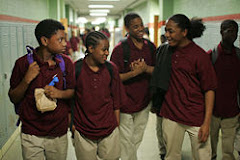Kids write on desks. I try to stay on them, but it's sometimes hard. It's especially hard this year, when I have another teacher with a rowdy class who uses my room everyday. On Monday, she caught a young man writing in magic marker on a desk. I was already getting frustrated with all the writings and doodles on the desks - and it also includes several gang signs and callouts to gangs ("Crypt Nation", for example - but this was the straw that broke the camel's back.
I went out and bought a gallon of bleach and some Clorox bleach spray and soaked and then scrubbed the desks. By the end, they were gleaming, and the bleach got out everything but the very harshest magic marker.
Some of the kids were impressed today. Others just complained about the bleach smell in the room, which will probably be there for weeks. Still, it felt good. And I'm watching those desks like a hawk now.
*****
Pretty exhausted this week; I feel like every day is a 14-hour day, as I leave the house at around 5:30am and return after 8:00pm. Still, my To Kill a Mockingbird unit is starting off well. My goal - get kids to love this book. There are other skills goals and stuff like that, but, really, I'm feeling the need to foster a love in reading that I don't think I have yet this year.
Here's my first assignment of the unit:
MYP English I
To Kill a Mockingbird HW #1
Description of Setting
Directions: Read Harper Lee’s description of Maycomb. Notice that its tone is nostalgic, meaning it looks back at the past with wistful reflection or longing. Read it with a slow, even rhythm and notice the following:
How the punctuation she uses (particularly the semicolons and colons) helps to create this rhythm naturally. What would the passage be like with a lot of short sentences?
How all the details she includes help to set the scene – you can see and feel the lazy and hot summer day. What details are especially important?
Any choices of diction that are especially striking.
Lee’s use of alliteration, visual imagery, foreshadowing, tactile imagery, personification, parallelism, and historical allusion*
* The last line, about having “nothing to fear but fear itself” comes from President Franklin D. Roosevelt’s Inaugural Address in January 1933, in the midst of the Great Depression.
Mark the following passage for the above devices and details:
Maycomb was an old town, but it was a tired old town when I first knew it. In rainy weather the streets turned to red slop; grass grew on the sidewalks, the courthouse sagged in the square. Somehow, it was hotter then: a black dog suffered on a summer’s day; bony mules hitched to Hoover carts flicked flies in the sweltering shade of the live oaks on the square. Men’s stiff collars wilted by nine in the morning. Ladies bathed before noon, after their three-o’clock naps, and by nightfall were like soft teacakes with frostings of sweat and sweet talcum.
People moved slowly then. They ambled across the square, ambled in and out of the stores around it, took their time about everything. A day was twenty-four hours long but seemed longer. There was no hurry, for there was nowhere to go, nothing to buy and no money to buy it with, nothing to go see outside the boundaries of Maycomb County. But it was a time of vague optimism for some of the people: Maycomb County had recently been told that it had nothing to fear but fear itself.
Assignment: Write a similar 2-paragraph description of Baltimore with a nostalgic tone. It should sound like it was written by Harper Lee, but be about Baltimore, with details that describe Baltimore (or the people of Baltimore). After you finish, text-mark it for the devices that you use.
Resep Masakan
11 years ago

3 comments:
Hair spray will often take out permanent marker.
bdc
I wonder if that last part would mean anything to the kids you are teaching, most of whom have lived their conscious lives in this century and have very little sense of this country's history. Would it be helpful to give them some of the historical context of the setting? It might be relevant today to talk to them about FDR and the Great Depression, let them listen to FDR's speech that includes that quotation.
You definitely don't need historical context to understand "hot". Many of your students have probably endured Baltimore summers without A/C - shucks, just sweating through your class on a hot September day with the smell of cafeteria dumpsters wafting through the open windows would probably drive that point home.
I always liked the line about the black dog for some reason. Black dogs suffer more on those hot days. Poor black dogs - sure must be hot. Maybe someone should shoot the dog and put it out of its misery - I guess that will have to wait for later in the story.
Have fun - I know how much you love Harper Lee and this book. That's always the best - to teach what you love and enjoy.
For the desks you can use the Mr. Clean Magic Erasers next time. As effective as bleach, easier, and with no smell at all.
Post a Comment